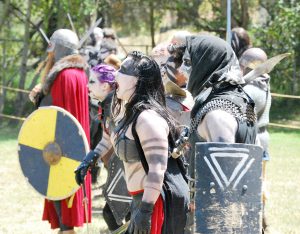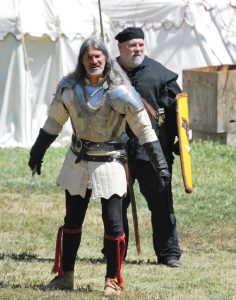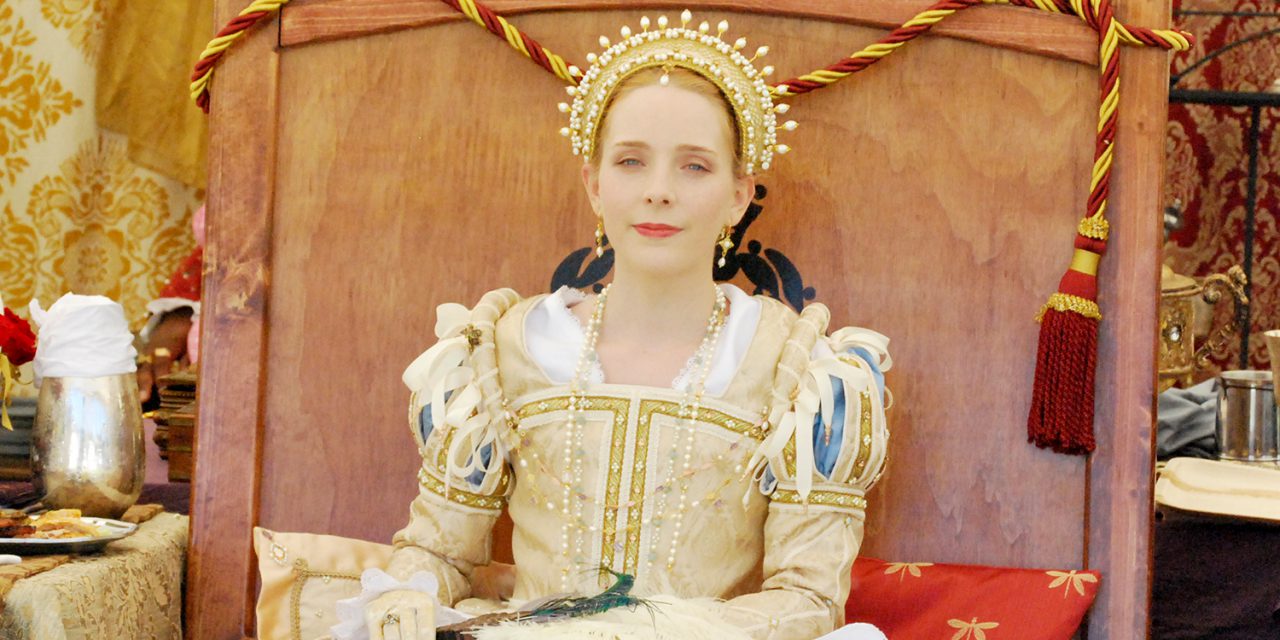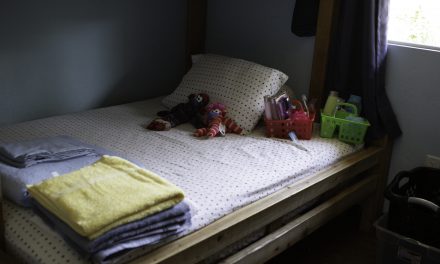Impact Staff
The first spark of ingenuity that came to be synonymous for the Irwindale Renaissance Pleasure Faire for this lucky patron was two men standing upon a bridge over the entrance. One had a beard the color of snowfall, and the requisite uniform of what seemed a pirate: breeches and a smarmy smile. The other was slighter, brown-haired, and in a similar dress. Even from my position near him, I could feel the roguish air he was putting on. “And to the city of Irwindale which has been our home for 14 years,” the white-haired man cried.
“Hip hip HUZZAH!” From around the courtyard rose cries of joy and excitement as the gates of the Irwindale Renaissance Pleasure Faire opened to patrons.
A group of teenagers stood in medieval garb, their mouths stretched wide in excitement. One of them let out a frenzying cry and jostled his friends, fully in character of a court jester. One man strode up to them, a papier-mâché looking creature protruding from his chest, presumably a dragon. It was hard to hear his words, but the crowd of teenagers embraced him. They were united in their character appreciation for each other on this special day.
But the opening spectacle was far from over: “What is wrong with you boys,” a woman in a billowing dress demanded. Her face was pinched, and she waved at the men over the faire entrance. “We did have a large portion of wine,” the white-haired “pirate” smiled apologetically. The audience shook with laughter as we allowed the centuries-old humor to wash over us, and clapped once the actors gave pause enough to take a bow.

Performer(s) at the Escondido renaissance fair. April 28. Linus Smith / Impact Magazine
Once inside, a rainbow of color met the eyes. Children clad in breeches and bonnets roamed the areas as people gathered by their favorite stands. Some people had attached prosthetics to their ears to give the appearance of elves. A few patrons were fully painted in hues of light blues and greens. Women with long stretched out British accents bartered back and forth in the street, with some verbally slapping their husbands for being lushes.
A man looked up and demanded that his canvas monster of a carrying vestibule be traded for a passerby’s sleek backpack. Farther on in the fair, children in modern-day dress could be seen perfecting their arrow shooting skills. People covered in costume attire sat watching on haystacks as performers juggled what looked like bowling pins on a wooden stage. “Go on, have a shot,” a man in charge of some kind of hoop game urged.
Screeches could be heard as a blue-tinged dunking tank resulted in a swim for an unfortunate volunteer. As the music of trumpets and bagpipes filled the air and a person carrying a turkey leg the size of two fists passed by, it was tempting to slip into the vestiges of an age long buried under the pursuit of glass screens and skyscrapers.
The Irwindale Renaissance Faire was the brainchild of Phyllis Reynold in the 60’s and denoted as the official start of medieval fairs in the United States. However, medieval reenactments happen in many European countries, as well. The culture, especially in the United States, revolves around playacting. Costumers come in the shapes of queens, princesses, peasants, blacksmiths, and other Middle Ages roles.
It was luck to run into both William Shakespeare and Queen Elizabeth I. While the queen was only visible as the figurehead of an ornate parade, William Shakespeare was open to talking about his house (theater) performances and the way he fashioned words into reality. His green eyes snapped as he recounted his existence living at Stratford Upon Avon, and his wish to finally meet the queen one day. It was a performance that ran for 10 minutes, and he was engaging, asking about favorite plays of his, and giving two theatrical kisses upon the hand, fit with a curtsying flourish. “I give [stories] flesh so they may be played upon a stage,” he said.
“I am a rebel rouser,” Layla Cabbylcara announced. She rang off her creed with an air of sardonic amusement. Her partner in crime, Nutmeg Carter, smiled widely. Dressed in long, flowing dresses, the gals also donned sleeves that had the puffed look requisite of the Elizabethan time era. Their official job appeared to be making sure that nobody brought in real weapons to the fair or caused an unwanted cacophony of violence.
Apparently, one year, the honey wine had gone to the heads of a group of men and it had been hard to subdue them. These women had everything under control for today, however, and deigned for an interview. Cabbylcara recounted, “I have been me a member of this community since before I were born,” which was taken to mean that her own mother had been a part of the fair community, and Layla was continuing the tradition. “We are a family of a thousand people strong,” she said, and her eyes lit up. Carter added, “We like to make people happy.”
A young man tending his spices, who went by the name of Jackson Ruscio looked out from behind a table filled with small glass jars, each filled with different colored minerals. Ruscio told that “he’d tried smelling some of them before the fair opened, but advised against it.” It seemed that most people walking around were susceptible to the air of pretend that enveloped the fair. More than that, they loved to alter their own voices and visages to further cater to the appeal of a time before their own. One could speculate why people of 2018 are continuing this tradition from a time when there wasn’t nearly as much ease. Could they prize a time of jousting and bloody overthrowing of a Catholic ruler over the predictable wane of a smartphone-dominated culture?
If this is so, are medieval fairs a way for people to pop into a simpler time, engage their fantasy, and then revert back to a life of creative limits? Many get nostalgic over Star Wars films, which is said to have been a major driving force in the blockbuster status of the 2016 film. The same perspective could be applied to fairs for people who have a vision of Renaissance times as the sweet period of knights and fair maidens that has been provided by Hollywood.
However, for Becca Gorken and her husband, the faire was only one stop along many other renaissance inspired centers of interest where they could sell their wares: mainly leather covered objects. According to Gorken, she “made 25 to 30 percent” of what was featured in her shop. The majority of what they were selling were books covered in the leather material.
Not only did the Gorkens sweep the fair circuit (40 cities in a year, she reported), they also showed up at various Comic Cons. In an interesting twist, Goken shared that the performers and vendors had an agreement, in which the performers helped people realize a renaissance-driven time period, while the vendors performed more of a commercial aspect. Patrons would be swept into their fascination of the era, and want to bring the fair to their homes through fair-authentic objects.
In this way, it was easy to feel cynical. After all, it was just art and money, thrown together. But as Becca Goken shared more of her story, one could tell that she really felt home in the circuits; “I like it,” she said. “I get the phone calls, you know telemarketers. They ask me, “Do you need a vacation?” and I say, “My life is a vacation.” She expressed being in a new city every weekend and liking the people. Her husband came by and she hugged him. It was easy to see their dynamic; he was tall and steady, and she made lots of little movements, coupled with laughter at random intervals. Imagining her at a desk was nigh impossible.
The Gokens are only one figment of the colorful parade of employees that make up the medieval renaissance culture. To become an actor in the fair, there are very specific hoops one is put through. First off, authenticity is key. No one will believe one is a blacksmith if one doesn’t have any metal materials lying around. For this role, in addition, one must carry a British accent, know culture of the Elizabethan era, explain to audiences the intricacies of making a usable sword, be dressed in a costume that fits the aforementioned time period, be

Performer(s) at the Escondido renaissance fair. April 28. Linus Smith / Impact Magazine
light on one’s feet if an audience member asks for one’s back story, and much else. An event that comes to mind when trying to fully understand the importance of authenticity to the overseers is the Irwindale Renaissance Pleasure Faire. If one is still willing to be an actor performing in a renaissance-themed playground, then they may be saddened to hear that renaissance actors barely earn above the belt. In fact, Medieval Times, a corporation that puts on medieval spectacles, pays its actors between $24,000 and $32,000. Maybe a good salary for a person trying to make it on their own, but one could argue that it would certainly leave a family struggling.
A man who went by the name of Tom was hesitant to stop for an interview, saying, “I gotta do my job.” It broke the magic for a little, but also added a touch of self-awareness to the place where Tom was working: the Irwindale Renaissance Pleasure Faire. Nothing comes for free, not even what may have been a childhood dream for Tom. The place was only possible because people put aside millionaire dreams to entertain and maybe get a little magic on themselves in the process.
Becca and Megan and the nameless actor who portrayed William Shakespeare found fulfillment in giving people what Becca called “the illusion of a show.” What’s more, the audience was in on the illusion as well. Judging by the huge crowds, it wasn’t hard for a lot of adults to pay up the $30 that it cost them to enjoy the renaissance festival for a day. Maybe even if it seemed small to put off life in the 21st Century for a little while, the happiness it afforded gave many people smiles and looks of wonderment.






Recent Comments